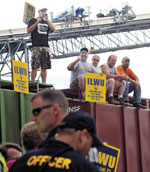
Showdown on West Coast Docks: The Battle of Longview
(November 2011).
click on photo for article
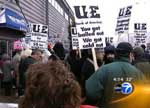
Chicago Plant Occupation Electrifies Labor
(December 2008).
click on photo for article
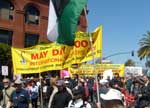
May Day Strike Against the War Shuts Down
U.S. West Coast Ports
(May 2008)
click on photo for article

August 2022
Whatever Happened to “No Contract, No Work”?
ILWU:
Prepare to Strike for Shorter Workweek, Union
Control of Tech
Fight for 6-Hour Shifts x 5 = 30 Hours, No Loss in Pay
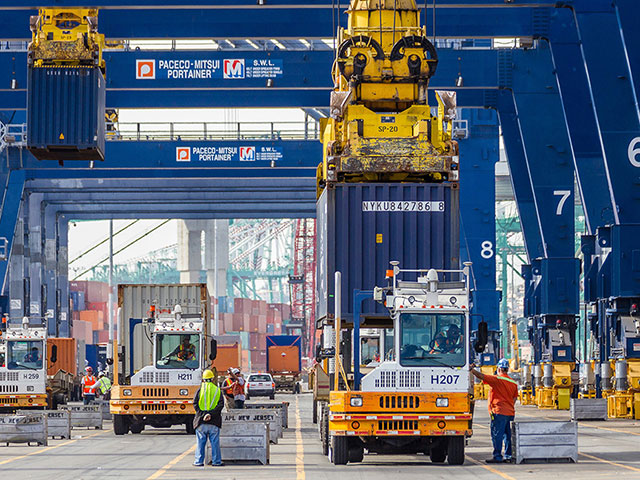
Automation at the Port of Los Angeles (above) has been carried out at a cost of over 500 full-time jobs. ILWU should fight for union control of technology, 30-hour workweek, jobs for all. (Port of Los Angeles)
AUGUST 6 – With the July 1 expiration of the contract between the West Coast International Longshore and Warehouse Union (ILWU) and the maritime companies, the stage was set for a major showdown and the possibility of a big labor victory with reverberations across the country. Instead, as the clock ticked down on June 30, the ILWU tops and the maritime bosses issued a joint statement: “While there will be no contract extension, cargo will keep moving, and normal operations will continue at the ports until an agreement can be reached between the Pacific Maritime Association (PMA) and the International Longshore & Warehouse Union” (Logistics Management 6 July).
As the contract expired, the PMA added its own statement: “We are proud of our collaboration with the ILWU during this extraordinary period and hopeful that spirit of cooperation will continue as we pursue a new agreement.” No doubt. For the shipping bosses, patting the ILWU negotiators on the head for keeping the freight moving makes sense. For the longshore rank and file? Not so much.
Then, a month later, on July 27, the union and PMA announced a tentative agreement on health benefits. “Maintenance of health benefits is an important part of the contract between employers represented by the PMA and workers represented by the ILWU” (Journal of Commerce, 27 July). With health care costs going through the roof, employers around the country have threatened to cut those benefits. But health care is only part of a contract. The same article noted that “the likelihood is growing that a deal will be reached in August or September with little disruption occurring on the docks.”
“August or September”?! ILWU members have already been working for a month without an agreement. What happened to “No contract, No Work”? The ILWU is one of the most powerful unions in the country. There is no contract. The odious no-strike clause doesn’t exist. While the ILWU leadership has made it clear that it’s opposed to a strike, class-conscious militants should demand a strike vote and gear up to shut down the West Coast, now! If there is a walkout, the rest of labor should back up the ILWU, joining picket lines and refusing to handle struck cargo. A victorious longshore strike will benefit unions and working people everywhere in looming battles fueled by runaway inflation.
The companies are flush with cash. According to the maritime research consultancy Drewry, "Ocean carriers have generated about $190 billion of annual profits and about $130 billion of fresh cash in 2021, obtained mainly by charging higher prices” (Offshore Energy, 23 February). That’s more than seven times what they made in 2020! “They are projected to rake in another $200 billion this year, as they continue to take advantage of the supply chain snafus to increase shipping rates,” reported Rachel Phua in Payday Report (1 July). The charges for a 40-foot box shipped from China to the West Coast hit a record $20,000 last August, and are still around $9,000. “Before the pandemic, they were below $2,000,” Phua noted. Even though they are gorged with profits, the maritime bosses are demanding concessions from the ILWU.
The ILWU Has the Power – Use It!
The union has tremendous leverage and should use it. Los Angeles/Long Beach/San Pedro is the port of entry for 42% of container freight shipped from Asia to the U.S. In 2021, the Port of Los Angeles became the first port in the Western Hemisphere to process 10 million container units in a 12‑month period. Port bosses worry that a walkout could create havoc in the already snarled supply chain. They weren’t the only ones worried about a strike. On July 1, more than 150 local, state, and national business and trade associations wrote to President Joe Biden and urged him to ensure that there would be no work stoppage. “We know the administration understands the economic significance of these negotiations” (Reuters, 1 July).
You bet it does. On June 10 Biden met with PMA and ILWU reps in San Pedro Bay aboard the Battleship USS Iowa. Four days later, the PMA and ILWU tops announced that cargo operations would “continue beyond the expiration of the contract.” Mission accomplished. “Neither party,” the statement added, “is preparing for a strike or a lockout” (Logistics Management, 14 June). The ILWU bureaucrats certainly weren’t prepared for a fight – they haven’t even held a strike vote. But the bosses sure are: a one-sided fight.
“U.S. Container Imports Jump in April as Coastal Shift Continues,” headlined The Loadstar (17 May), a shipping logistics newsletter, stating: “the coastal shift by shippers from the west coast to east ports appears to be gaining fresh momentum ahead of the expiry of the US west coast labour agreement on 1 July.” PMA Chief Executive Officer Jim McKenna was even more explicit: “If they don’t come to a compromise, then freight will get permanently diverted to the East Coast” (New York Times, 28 March).
In the event of a West Coast strike, the shipping bosses will undoubtedly make good on their threat to shift cargo to other North American ports. Solidarity across borders and jurisdictional lines would be crucial. Longshore workers in the Canadian ports refusing to handle struck cargoes from the U.S. will be key. The same goes for Gulf and East Coast ports such as Houston, New Orleans, Charleston, Port Newark, etc., where dock workers are represented by the International Longshoremen’s Association (ILA).
“I want the word to go out that the ILA stands firmly behind our West Coast longshore workers,” union president Harold Daggett said in a video message on May 12. But Daggett did not say that the ILA would carry out any action in solidarity with the ILWU. Action, not empty solidarity messages, is what’s needed. Struck cargo is scab cargo! For joint ILWU and ILA action! Likewise, Dennis Daggett (son of the ILA president), who is general coordinator of the International Dockworkers Council (IDC), called upon member unions to back the ILWU “with declarations and resolutions of support.” But Daggett Jr. just expelled left-led dockers unions in France, Spain and Sweden from the IDC!
Right now, there is a real opportunity for actual international solidarity, as opposed to empty words. On July 14-15, thousands of German port workers struck for 48 hours in Hamburg and other North Sea ports. Across the Channel, where workers are facing the highest inflation in four decades, a summer of strike action by railway workers began with a three-day walkout by the Rail, Maritime and Transport Workers (RMT) union, at the same time as London Tube (subway) workers struck for a day, which taken together was the biggest British rail strike in 30 years.
This wave of strike action in Britain continued the next month, with rail work stoppages on July 16, 23, 27 (when 40,000 RMT-led workers struck) and 30, when 5,000 locomotive engineers represented by the ASLEF train-drivers union walked out. ASLEF has scheduled another walkout for August 13, while the RMT is going out on August 18 and 20. Industrial action also hit rail companies in Scotland. This “summer of discontent” is the biggest outbreak of strikes in the United Kingdom since 1989. But as long as they are separate, time-limited actions, their power is undercut. A national rail and transit strike at this time, with the fall of the government of the corrupt warmonger Boris Johnson, could lay low the lords of industry who have royally profited, both before and after Britain exited the European Union, as working people are seeing their living standards plummet.
In the U.S., railroad workers – who have gone without a pay raise for three years – could link up with the ILWU in powerful joint action. On July 12, the membership of the Brotherhood of Locomotive Engineers and Trainmen (BLET), a division of the Teamsters, voted by 99.5% to strike. The BLET is one of 13 rail unions in negotiations for a national contract. A federally ordered “cooling-off period” expired on July 18, whereupon Biden issued an executive order setting up an emergency board and prohibiting a walkout for another 60 days.
>Outrageously, Greg Regan, president of the Transportation Trades Department of the AFL-CIO, hailed Biden’s action. But a strike simultaneously shutting down trains and West Coast harbors could rip up those strikebreaking orders. Picket out the intermodal rail yards! And as the capitalists who run the maritime industry prepare to shift cargo from the West to Gulf and East Coast ports, common strike action by the ILWU and ILA could land an unprecedented blow against the bosses whose profiteering has been driving an inflationary spiral even as the economy sinks into recession.
Across the country, people can’t make ends meet because of soaring prices at the gas pump and supermarket. A hard-fought longshore strike could show the way to fight back. What will it take to win?
- From the Mexican border to Canada: Shut down the docks, terminals and warehouses! Build strong picket lines that no one dares cross!
- For “fishbowl negotiations,” a union tradition, open to all ILWU members. Form a mass strike committee of representatives to be elected at every dock and warehouse.
- Build strike support committees with other unions, unorganized workers, community groups and students, such as with ILWU Local 10’s joint actions with Oakland teachers.
- Push through a shorter workweek – five shifts of six hours each – with no loss in pay, and full-time jobs for casuals. A decent standard of living shouldn’t depend on racking up hundreds of hours of overtime.
- Hardline it for a big wage hike with COLA (cost of living adjustment) to protect against the ravages of inflation.
- For union control of new technology, which must not be used to kill jobs – elected union committees to sign off on any automation.
- Abolish the Group System of A, B and Identified Casual. Longshore workers need unity in preparation for a strike. Divisions in the union’s ranks only work in PMA’s interest.
Organize Port Truckers and Warehouse Workers Into the ILWU
While ILWU longshore workers and clerks have been working without a contract, ports have been thrown into turmoil as port truckers picket to protest California’s AB5 law. The law was passed in January 2020 as a result of a push to enable Uber and Lyft drivers, and other workers in the “gig economy,” to unionize, be eligible for unemployment benefits, and be covered by minimum wages, overtime pay, workers’ comp and other job protections for employees. This was done by eliminating the fiction that they are “independent contractors” when their labor is in fact under the control of the giant app-based taxi and delivery companies.1
Uber and Lyft spent millions of dollars to finance Proposition 22, which passed in the November 2020 elections, to exempt their operations and prevent the legislature from passing future legislation on the issue.2 However, in 2021 the federal district court ruled against a suit brought by the California Trucking Association (CTA) to prevent AB5 from being applied to the trucking sector, and this past June 30 the U.S. Supreme Court denied an appeal of that ruling. So now the intermodal trucking companies which run dozens and even hundreds of owner-operated rigs, many of them leased, will no longer be exempt from job protections and unionization.
On July 14 and 15, hundreds of short-haul (drayage) truck drivers who move cargo from the ports of Los Angeles and Long Beach jammed traffic on Interstate 710 to protest AB5. And then, from July 18 to 25, truckers in Oakland picketed the port for a week. The terminal operators were livid when ILWU Local 10 members refused to cross the picket line. “Some offered tips on where to stand and hold up signs to block certain gates to ‘be more effective’,” Freightwaves (1 August), an industry publication, reported. Local 10 members said longshore workers were working without a contract, so they sympathized with the owner-operators.
We support AB5 and its application to the freight carriers, who hide behind the “independent contractor” classification of their drivers in order to avoid granting basic labor rights. Class-conscious workers would not support the demands of the protests that were organized by the trucking bosses of the CTA. But any real trade-unionist would, on principle, refuse to cross the picket lines. A class-struggle leadership would seek to link the interests of the heavily immigrant port truckers to the longshore workers, which could include directly unionizing fleet workers and forming a cooperative of owner-operators linked to the union, with union control of dispatching.
Unity between longshore workers who unload cargo and the truckers who move it inland would be a mighty force. It could also spearhead an organizing drive of the warehouses they deliver to. The ILWU has an often-overlooked history of organizing warehouse workers. This is detailed in Harvey Schwartz, The March Inland: Origins of the ILWU Warehouse Division.3 Schwartz notes that in 1933 there were no unionized warehouse workers in the Bay Area, but in the wake of the 1934 San Francisco general strike, “nearly all of the region’s 8,500 freight handlers belonged to one of the largest and most powerful union locals in the country.”
That history holds lessons for those today seeking to unionize Amazon. The e-commerce giant has warehouses in the SF Bay Area and all over the Los Angeles metro area. Recently it announced plans for its largest-ever “fulfillment center” in Ontario, California, in the Inland Empire east of L.A. A successful organizing campaign at Amazon, and other virulently anti-union companies like Walmart, will not win on a warehouse-by-warehouse, store-by-store basis with votes according to the rules of the National Labor Relations Board, a government agency set up to tame militant labor. Instead, it will take a full-fledged labor revolt on the scale of the SF longshore workers’ ’34 Big Strike.
Building on the victory of the Amazon Labor Union in Staten Island, NY, in April, a militant West Coast longshore strike that sought solidarity with port truckers and warehouse workers could go a long way toward turning the L.A. metro area into union country, and spark a drive to organize the unorganized nationwide.
The Threat of Militarization of the Ports
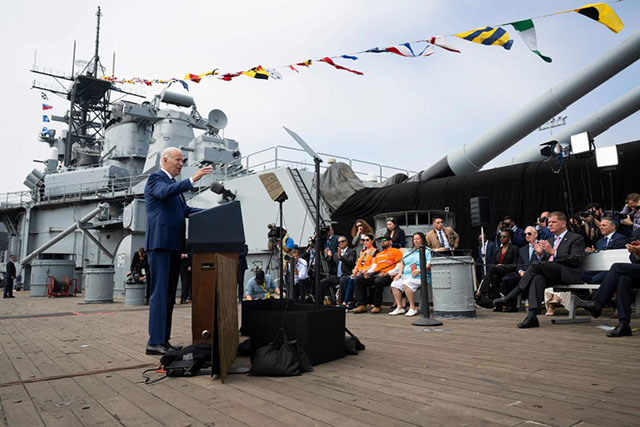
President Joe Biden, aboard the USS Iowa on June 10, orders ILWU and PMA to keep working. U.S. rulers use “national security” to avoid labor strikes at the ports. But longshore workers have the power to shut it down. (Jim Watson / AFP)
In October 2021, amid the pandemic-linked supply chain crisis, Biden convened a White House roundtable of “stakeholders” in the shipping industry to declare a “90-day sprint” to clear cargo logjams. Attendees included transportation secretary Pete Buttigieg, vice president Kamala Harris, ILWU president Willie Adams, the executive directors of the ports of Los Angeles and Long Beach, and (attending virtually) the heads of UPS, FedEx, the American Trucking Association, American Association of Railroads, Walmart and other corporate executives. Biden pressed for 24-hour operations of West Coast ports, to which the union leader replied that this was already provided for in the contract with the PMA, shippers just have to put in the orders.
But the problems persisted. At his June 10 meeting with ILWU and PMA leaders aboard the Iowa, it was not just moving consumer goods Biden was concerned with. He announced there that the new port envoy to the federal, supply chain task force is retired four-star general Stephen Lyons. Previously, Lyons led the U.S. Transportation Command, which co-ordinates military and commercial resources missions worldwide. Ports are, and always have been, critical to U.S. imperialism. For the Pentagon, labor peace on the docks is a “national security” issue. A report by the Committee on Military Transportation of the National Academies’ Transportation Research Board, part of the mammoth compendium Transportation in the New Millennium (2000), states:
“most military cargo, personnel, and war-fighting assets now move on commercial assets. For example, more than 95 percent of the equipment and cargo shipped in Desert Shield and Desert Storm moved on commercial carriers. Because of this, DoD instituted agreements with commercial carriers to ensure asset availability when needed.”
This is nothing new. Containerization, first introduced in 1956 by trucking magnate Malcolm McClean, completely transformed shipping worldwide. Rather than fight to preserve jobs, ILWU president Harry Bridges negotiated the disastrous 1960 “modernization and mechanization” agreement. This led to a huge loss of longshore jobs and introduced the destructive division of ILWU members into A, B and casuals, with only “A men” guaranteed work. The New York Times (13 May 2006) later reported, “The key moment came during the Vietnam War, when Mr. McLean proved to the United States military, which had become increasingly frustrated at the difficulty of shipping materiel to the war zone, that his way was the only possible solution. Once the armed forces became converts, there was no turning back.”
Today you can be sure that military needs will once again be a major factor in ramming through port automation. That will also be a main excuse for government attempts to block a West Coast port shutdown, as it was in 2002. That July, during the build-up to the U.S. invasion of Iraq, the Homeland Security secretary called ILWU president Jim Spinosa to warn that a longshore strike was not in the “national interest,” while draconian legislation to militarize the docks, the Port and Maritime Security Act, was passed unanimously by the Senate amid the war hysteria following the 9/11 attacks on the World Trade Center and Pentagon. When the PMA locked out workers in October 2002, Democratic senator Diane Feinstein called on Republican president George Bush II to impose a Taft-Hartley injunction to order the ILWU back to work, which he did. The Internationalist called at the time for the ILWU to “hot cargo” war material, and to mobilize labor to smash Taft-Hartley.
In fact, Democratic as well as Republican administrations have used that strikebreaking, union-busting slave labor act against the unions. Democratic president Jimmy Carter invoked it against coal miners in the 1977-78 coal strike,4 while the Democratic Obama/Biden administration used the Coast Guard to break the ILWU mobilization against the opening of the scab EGT grain terminal in Longview, Washington in 2012. ILWU International president McEllrath collaborated with the government by ordering longshoremen to work at the terminal without a contract.
Over and over, the U.S. labor bureaucracy have knuckled under to government anti-union repression. But the ILWU was built by “reds” and fought the “red purge” engineered by the Democrats at the start of the anti-Soviet Cold War, particularly the attempts to deport Harry Bridges and to drive the ILWU off the docks. On May Day 2008, the ILWU stopped work on all 29 West Coast ports to protest the U.S. war on Iraq and Afghanistan. When the PMA tried to sue for violation of Taft-Hartley, the union told the PMA to drop it or face a contract strike.5
The ILWU has also stood tall against racist repression. In April 1999, the union shut West Coast ports demanding freedom for Mumia Abu-Jamal, the former Black Panther and radical journalist held for more than 41 years on a frame-up charges of killing a cop. And on 19 June 2021 (“Juneteenth”), in the wake of the police murder of George Floyd, the ILWU shut down all West Coast ports in the U.S. and Canada. It was a dramatic demonstration of workers’ power in defense of the oppressed. Today, a militant ILWU strike could galvanize support across the region. Important allies would be teachers, parents, and students in Oakland, where on February 17, ILWU Local 10 and the Oakland Education Association (OEA) held a mass mobilization against construction of a new A’s stadium at the port and the closing of public schools to be replaced by charters. Then on April 29, ILWU Local 10 and the OEA carried out a first-ever joint one-day strike against the privatization of public schools and at the port of Oakland.
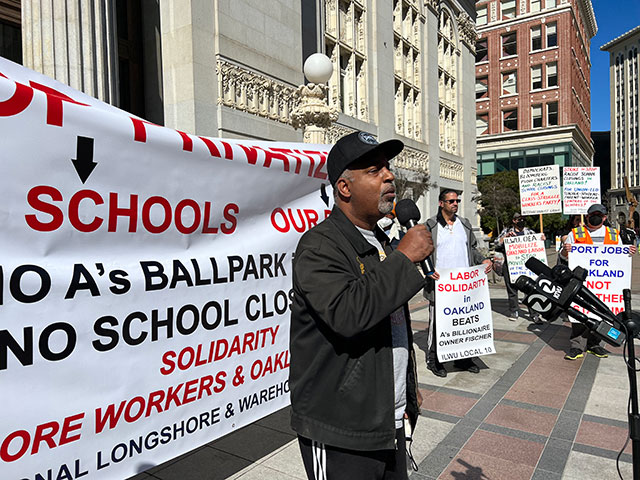
ILWU Local 10 and Oakland Education Association have taken joint strike action against privatization of the port and schools. Above: Local 10 past president Trent Willis speaking at February 17 walkout and rally of longshore workers and teachers. (Photo: Labor Video Project)
What is crucially needed in the ILWU – and the labor movement as a whole – is a leadership with audacity and a class-struggle program to fight to win. Playing by the bosses’ rules has brought us to where we are today. Long ago, the U.S. union bureaucracy sold its soul to the Democratic Party, which isn’t any kind of “friend of labor” but rather a chain anchoring workers to the capitalist class. To wage a successful longshore strike, the ILWU must be prepared to fight not only on picket lines, but also politically against the ruling parties of U.S. imperialism. You can be sure that if the ILWU walks out, Democrats and Republicans will unite to accuse the union of sabotaging the war effort against Russia and China. And you can expect that the union leadership, which last March announced it was refusing to handle Russian cargo, will salute and go along.
The ILWU has the power to defeat the capitalist onslaught. That’s why the shipping and stevedoring companies desperately want to automate the union into oblivion, along with the ILA and dock unions worldwide. To fight defeat that threat, it is necessary to oust the pro-capitalist bureaucrats, break with the Democrats and build a revolutionary workers party to fight for a workers government. ■
Against PMA’s “Robo-Dock” Fantasy,
Fight for Union Control of Technology
Automation is a central issue in the present contract bargaining between the International Longshore and Warehouse Union (ILWU) and the bosses’ Pacific Maritime Association (PMA). According to PMA chief Jim McKenna, it’s “the key to long-term survival, long-term competitiveness” (Bloomberg, 3 May). Ten days before the start of negotiations with the ILWU, the PMA released a study titled Terminal Automation in Southern California: Implications for Growth, Jobs, and the Future Competitiveness of West Coast Ports (2 May 2022).It states:
“Automation offers considerable operational, economic, and environmental benefits. Remotely-controlled software-assisted cranes unload ships around the clock; autonomous vehicles efficiently move containers around the terminal; automated mobile cranes stack them, organizing the container yard overnight for fast, efficient loading onto … trucks and trains the next morning; and digital checkpoints reduce delays for trucks – speeding the flow of cargo into the supply chain.”
Anticipating union objections, the report says: “contrary to the ILWU’s concerns, automation at San Pedro Bay ports has added work, not come at its expense.”
This is false. As ILWU Coast Committeeman Frank Ponce De Leon put it back in May:
“Container volume has increased at the automated terminals, but this has been at the expense of other terminals that have had an offsetting drop in container volumes.... The increased productivity that the PMA is claiming at the two automated terminals has meant less work at other terminals and an overall loss of employment for longshore workers.... We haven’t seen an overall increase in productivity at the ports, just a shell game to mask the human cost of job destruction.”
–Daily Breeze, 4 May
A study by the Economic Roundtable, underwritten by the ILWU, Someone Else’s Ocean: Dockworkers, Foreign Shippers and Economic Outcomes (June 2022), spells this out: “A conservative analysis of job loss shows that automation eliminated 572 full-time-equivalent jobs annually at LBCT [Long Beach Container Terminal] and TraPac [Trans Pacific Container Service Corporation].”
The long-range plans of the bosses are clear. A third study, The Future of Automated Ports (2018), by management consultants McKinsey & Co., concludes with a section, “Beyond automated machinery,” stating:
“Forward-looking ports will push toward this next horizon, beyond automation, in the coming Port 4.0 era. Every player terminal operators, trucking companies, railroads, shippers, logistics companies, and freight forwarders will be connected to optimize not just the port itself but also its entire ecosystem.”
In the bosses’ vision of the future, workers – and unions – are not even mentioned.
Make no mistake – a key aim of this automation push is union-busting. Capitalist automation is a dagger pointed at the very existence of the ILWU. The bosses want to begin by enlisting the union leaders. In 2009, the Containerization and Intermodal Institute gave a joint award to ILWU International president Bob McEllrath and PMA chief McKenna, for negotiating a six-year contract without a strike. That’s clearly what shippers are aiming at today. Marxists do not oppose new technology as such. What we oppose is the companies seizing the fruits of technological advances – paid for with the sweat, blood and lives of workers – and then throwing the workers onto the scrap heap while the bosses rake in the profits.
How can workers stand up to the maritime bosses’ robo juggernaut? At a July 2017 educational conference on longshore work, automation and technology held at the ILWU Local 10 hall, Jack Heyman, retired member of the local and chairman of the Transport Workers Solidarity Committee, pointed to the lessons of the 1934 San Francisco general strike: “In the midst of the Depression, when millions of people were out of work, we fought for and won a six-hour day.” A shortened workweek with no loss in pay would create thousands more jobs. In addition, class-struggle militants would fight for union control of technology. For starters, this would include demanding that any steps to automate work be agreed to by the union, with full guarantees for workers’ jobs. ■
- 1. See “Finally! California AB5 Law Says App-Taxi Drivers Are Workers” (December 2019), in The Internationalist No. 58, Winter 2020.
- 2. See "Defeat Uber and Lyft Bosses’ Prop 22 in California!” The Internationalist No. 61, September-October 2020.
- 3. Originally published in 1978 by the Institute of Industrial Relations at the University of California, Los Angeles. Reprinted in 2000 by the ILWU.
- 4. See the pamphlet, <The Great Coal Strike of 1978, available online at www.internationalist.org.
- 5. See our articles on “May Day 2008: Port Strike Against the War,” in The Internationalist No. 27, May-June 2008. The Internationalist Group, which fought from 2001 on for workers strikes against the war on Afghanistan and then Iraq, played a role in preparing the 2008 ILWU walkout. See the October 2007 Internationalist special supplement, Why We Fight for Workers Strikes Against the War (and the Opportunists Don’t).